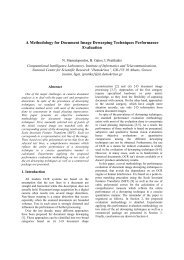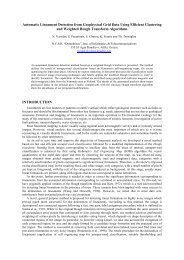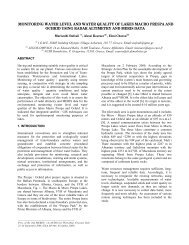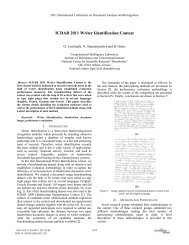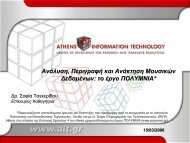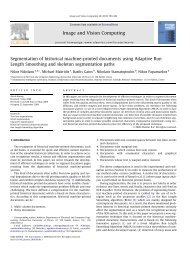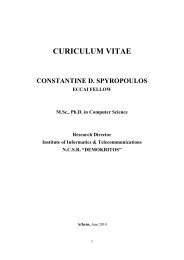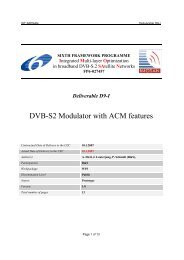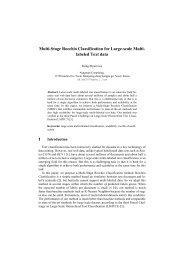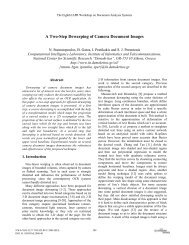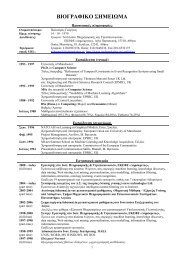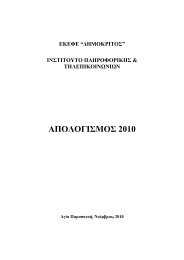TMS320C6713B Floating-Point Digital Signal Processor (Rev. A)
TMS320C6713B Floating-Point Digital Signal Processor (Rev. A)
TMS320C6713B Floating-Point Digital Signal Processor (Rev. A)
Create successful ePaper yourself
Turn your PDF publications into a flip-book with our unique Google optimized e-Paper software.
SPRS294A − OCTOBER 2005 − REVISED NOVEMBER 2005<br />
IEEE 1149.1 JTAG compatibility statement<br />
The <strong>TMS320C6713B</strong> DSP requires that both TRST and RESET resets be asserted upon power up to be<br />
properly initialized. While RESET initializes the DSP core, TRST initializes the DSP’s emulation logic. Both<br />
resets are required for proper operation.<br />
Note: TRST is synchronous and must be clocked by TCLK; otherwise, BSCAN may not respond as expected<br />
after TRST is asserted.<br />
While both TRST and RESET need to be asserted upon power up, only RESET needs to be released for the<br />
DSP to boot properly. TRST may be asserted indefinitely for normal operation, keeping the JTAG port interface<br />
and DSP’s emulation logic in the reset state. TRST only needs to be released when it is necessary to use a JTAG<br />
controller to debug the DSP or exercise the DSP’s boundary scan functionality.<br />
The <strong>TMS320C6713B</strong> DSP includes an internal pulldown (IPD) on the TRST pin to ensure that TRST will always<br />
be asserted upon power up and the DSP’s internal emulation logic will always be properly initialized when this<br />
pin is not routed out. JTAG controllers from Texas Instruments actively drive TRST high. However, some<br />
third-party JTAG controllers may not drive TRST high but expect the use of an external pullup resistor on TRST.<br />
When using this type of JTAG controller, assert TRST to initialize the DSP after powerup and externally drive<br />
TRST high before attempting any emulation or boundary scan operations.<br />
Following the release of RESET, the low-to-high transition of TRST must be “seen” to latch the state of EMU1<br />
and EMU0. The EMU[1:0] pins configure the device for either Boundary Scan mode or Emulation mode. For<br />
more detailed information, see the terminal functions section of this data sheet.<br />
Note: The DESIGN−WARNING section of the <strong>TMS320C6713B</strong> BSDL file contains information and constraints<br />
regarding proper device operation while in Boundary Scan Mode.<br />
For more detailed information on the C6713B JTAG emulation, see the TMS320C6000 DSP Designing for JTAG<br />
Emulation Reference Guide (literature number SPRU641).<br />
EMIF device speed<br />
The maximum EMIF speed on the C6713B device is 100 MHz. TI recommends utilizing I/O buffer information<br />
specification (IBIS) to analyze all AC timings to determine if the maximum EMIF speed is achievable for a given<br />
board layout. To properly use IBIS models to attain accurate timing analysis for a given system, see the Using<br />
IBIS Models for Timing Analysis application report (literature number SPRA839).<br />
For ease of design evaluation, Table 45 contains IBIS simulation results showing the maximum EMIF-SDRAM<br />
interface speeds for the given example boards (TYPE) and SDRAM speed grades. Timing analysis should be<br />
performed to verify that all AC timings are met for the specified board layout. Other configurations are also<br />
possible, but again, timing analysis must be done to verify proper AC timings.<br />
To maintain signal integrity, serial termination resistors should be inserted into all EMIF output signal lines (see<br />
the Terminal Functions table for the EMIF output signals).<br />
POST OFFICE BOX 1443 • HOUSTON, TEXAS 77251−1443<br />
95



